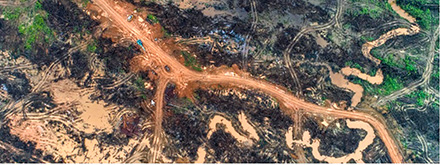In Sorong, a district in Indonesia’s eastern-most region of Papua, deforestation is unfolding. Indonesia’s commodities boom of recent decades razed much of the forests on the western islands of Sumatra and Borneo. Now, those same industries are moving into Papua. Sources: Timberbiz, Mongabay
In Papua authorities have issued licenses that could result in the clearing of an area the size of Sydney. That’s the finding from a new report by a coalition of 11 NGOs in Indonesia, which shows that most of the 1.1 million hectares (2.7 million acres) of natural forest that the government has authorized for clearing will be converted into oil palm plantations.
These licenses are known as forest conversion permits, which are required by law to allow plantations and infrastructure projects to be established in forest areas.
Dedy Sukmara, a researcher at the environmental NGO Auriga, a member of the coalition, said the issuance of these permits effectively legitimizes large-scale forest clearing.
“According to the law, this is legal deforestation,” he said. And this could spell disaster for the region’s wildlife and plants. Papua’s forests are among the most biodiverse on Earth home to at least 20,000 plant species, 602 birds, 125 mammals and 223 reptiles.
Historically, the issuance of forest conversion licenses has been followed to a small extent by deforestation, but new regulations could mean an even higher rate of clearing.
From 1992 to 2019, the government issued such licenses for 1.57 million hectares (3.8 million acres) of forest areas, of which 1.3 million hectares (3.2the past two decades. Under new regulations that set a tighter deadline for when license holders must start cultivating on their land, companies would be compelled to clear their concessions sooner or face punishment, Mr Dedy said.
“The recipients of the forest conversion licenses [are perceived to] not perform when they don’t utilize [their permits],” he said. “This shows the potential of a spike in deforestation in Papua in the next few years considering that there are many natural forests in the region that have been released [for plantations] and these [forests] are very threatened.”
In response to the NGOs’ report, the Ministry of Environment and Forestry released its own data showing there are at least 1.26 million hectares (3.1 million acres) of natural forests remaining in the areas that have already been earmarked for plantations as of January 2021.
These forests have remained largely intact, with only 2,645 hectares (6,536 acres) of deforestation identified by the ministry by January 2021. The ministry said it monitors this trend as part of wider efforts following up on a 2018 government moratorium on issuing new permits for oil palm plantations. The moratorium was imposed to improve the sustainability of the industry, and also calls for a review of existing permits.
The ministry said the monitoring by the central government is especially important because there have been no recommendations from local governments to revoke forest conversion permits in areas that are still forested.
“The ministry continues to monitor deforestation, whether through satellite-based monitoring or through field observation in certain levels, on the 1.26 million hectares of natural forests that are still spread in the areas zoned to be converted into oil palm plantations [in Papua],” it said in a press statement.






